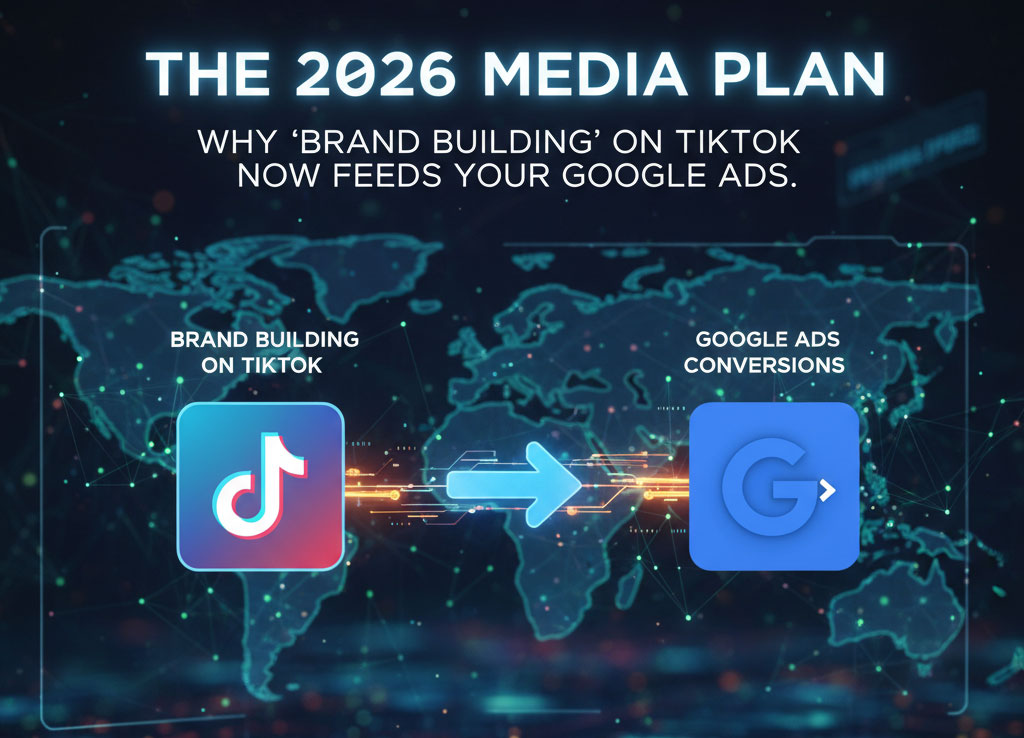
The 2026 Media Plan: Why “Brand Building” on TikTok Now Feeds Your Google Ads
It’s November. You’re in the 2026 budget meeting, and the C-suite is asking the same question: “Where do we put our ad spend to get the best ROI?”
For the last decade, the answer has been simple: Put the majority (say, 70%) into “bottom-of-funnel” channels like Google Ads to harvest existing demand. Put the other 30% into “brand awareness” on social media.
This model is no longer just outdated; it’s becoming a high-risk, low-growth liability.
Why? Two major shifts have changed the game:
- Google is getting more expensive: Clicks cost more, and AI Overviews are now “stealing” many of your highest-intent searchers before they ever click.
- Your customers have changed: Especially in the MENA region, Gen Z and a growing number of all users start their product discovery on TikTok and Instagram, not Google.
Relying only on “harvesting” a shrinking, more expensive pool of searchers is a failing strategy. You must create new demand. Here’s the chain of thought for a 2026 media plan that does just that.
1. The Old, Failing Model: Harvesting Only
The old model was built on the idea that “demand” was a pre-existing resource, like oil. Google Ads was the drill. Your job was to find people already searching “buy red shoes” and show them an ad for red shoes.
This was efficient, but it had a ceiling. You were limited to the number of people who already knew they wanted red shoes.
Now, with AI Overviews answering many of these simple queries, that “oil” is running dry. You have to find a new source of energy.
2. The New 2026 Model: The “Demand Creation” Engine
You can’t just harvest demand; you must create it. This means you need to shift your budget and your mindset to the Top-of-Funnel (TOFU).
This is where platforms like TikTok and Instagram Reels come in.
These are “discovery” engines. Users are not there to search; they are there to be entertained and inspired. Your job here isn’t to sell “red shoes.” Your job is to create a compelling, authentic video that makes a user stop scrolling and think, “Wow, those shoes look amazing. I wonder what that brand is?”
This is “brand building,” but it’s not the “fluffy” kind. It’s a direct-action strategy.
3. The “TikTok-to-Google” Funnel
Here is the new, winning media plan. It’s a two-step process:
Step 1: Create Demand (TikTok / Instagram Reels) This strategy involves dedicating a larger portion of your 2026 budget to “brand building” on social. By running “Lo-Fi” (low-fidelity), authentic-feeling videos that don’t look like ads, you can entertain, inspire, and build a genuine connection. This process is what creates a new, massive pool of “brand-aware” people.
Step 2: Harvest the Demand (Google / YouTube Ads) What happens 10 minutes (or 10 days) after a user sees your amazing TikTok video?
They don’t click a “link in bio.” They go to Google and they search for…
- “[Your Brand Name]”
- “[Your Brand Name] red shoes”
- “[Your Brand Name] reviews”
This is “branded search,” and it is the single most valuable, high-converting, and cheapest traffic you will ever get. Now, your Google Ads budget isn’t fighting everyone else for “red shoes.” It’s simply and cheaply harvesting the demand you already created on TikTok.
Your social media ads are now the fuel for your search engine ads.
The Takeaway
Stop thinking of your ad budget in a silo. Stop pitting “brand” against “direct response.”
The 2026 media plan is a loop:
- TikTok creates the “brand” desire.
- Google captures the “branded search” demand.
- The sales data from Google is fed back into your Meta/TikTok AI to find more people who look like your new customers.
Your 2026 budget must reflect this new reality. Stop overpaying to harvest a shrinking pool. Start investing in creating your own.
Ready to make AI data-driven decisions for your brand?
Creatives can help!
Our team of AI-powered digital marketing experts can guide you in harnessing the power of data to achieve your marketing goals.
Schedule a consultation to learn how our AI-powered solutions can drive growth.

